Database Security and Auditing: Protecting Data Integrity and Accessibility
Chapter 8 Application Data Auditing
Objectives
• Understand the difference between the auditing architecture of DML Action Auditing Architecture and DML changes
• Create and implement Oracle triggers • Create and implement SQL Server triggers • Define and implement Oracle fine-grained
auditing
Database Security and Auditing 2
Objectives (continued)
• Create a DML statement audit trail for Oracle
and SQL Server
• Generate a data manipulation history
•
Implement a DML statement auditing using a repository
Database Security and Auditing 3
Objectives (continued)
• Understand the importance and the
•
implementation of application errors auditing in Oracle Implement Oracle PL/SQL procedure authorization
Database Security and Auditing 4
DML Action Auditing Architecture
• Data Manipulation Language (DML): companies
use auditing architecture for DML changes • DML changes can be performed on two levels:
– Row level – Column level
• Fine-grained auditing (FGA)
Database Security and Auditing 5
DML Action Auditing Architecture (continued)
Database Security and Auditing 6
DML Action Auditing Architecture (continued)
Database Security and Auditing 7
Oracle Triggers
• Stored PL/SQL procedure executed whenever:
– DML operation occurs – Specific database event occurs
• Six DML events (trigger timings): INSERT,
UPDATE, and DELETE
• Purposes:
– Audits, controlling invalid data – Implementing business rules, generating values
Database Security and Auditing 8
Oracle Triggers (continued)
Database Security and Auditing 9
Oracle Triggers (continued)
• CREATE TRIGGER • Executed in a specific order:
– STATEMENT LEVEL triggers before COLUMN
LEVEL triggers
– BEFORE triggers before AFTER triggers • USER_TRIGGERS data dictionary view: all
triggers created on a table
• A table can have unlimited triggers: do not
overuse them
Database Security and Auditing 10
Oracle Triggers (continued)
Database Security and Auditing 11
SQL Server Triggers
• CREATE TRIGGER DDL statement: creates a
trigger
• Trigger condition:
– Prevents a trigger from firing – UPDATE() and COLUMNS_UPDATE() functions
• Logical tables:
– DELETED contains original data – INSERTED contains new data
Database Security and Auditing 12
SQL Server Triggers (continued)
• Restrictions—Transact-SQL statements not
allowed: – ALTER and CREATE DATABASE – DISK INIT and DISK RESIZE – DROP DATABASE and LOAD DATABASE – LOAD LOG – RECONFIGURE – RESTORE DATABASE – RESTORE LOG
Database Security and Auditing 13
Implementation of an Historical Model with SQL Server
• Create a history table:
– Same structure as original table – HISTORY_ID column
• Create a trigger: inserts original row into the
HISTORY table
Database Security and Auditing 14
Fine-grained Auditing (FGA) with Oracle
• Oracle provides column-level auditing: Oracle
PL/SQL-supplied package DBMS_FGA
• DBMS_FGA procedures:
– ADD_POLICY – DISABLE_POLICY – DROP_POLICY – ENABLE_POLICY
Database Security and Auditing 15
Fine-grained Auditing (FGA) with Oracle (continued)
• ADD_POLICY parameters:
– OBJECT_SCHEMA – OBJECT_NAME – POLICY_NAME – AUDIT_CONDITION – AUDIT_COLUMN – HANDLER_SCHEMA
Database Security and Auditing 16
Fine-grained Auditing (FGA) with Oracle (continued)
• ADD_POLICY parameters (continued):
– HANDLER_MODULE – ENABLE – STATEMENT_TYPES
• DBA_FGA_AUDIT_TRAIL: view the audit trail
of the DML activities
Database Security and Auditing 17
DML Action Auditing with Oracle
• Record data changes on the table:
– Name of the person making the change – Date of the change – Time of the change
• Before or after value of the columns are not
recorded
Database Security and Auditing 18
DML Action Auditing with Oracle (continued)
Database Security and Auditing 19
DML Action Auditing with Oracle (continued)
• Steps:
– Use any user other than SYSTEM or SYS; with privileges to create tables, sequences, and triggers
– Create the auditing table – Create a sequence object – Create the trigger that will record DML
operations
– Test your implementation
Database Security and Auditing 20
History Auditing Model Implementation Using Oracle
• Historical data auditing is simple to implement; main components are TRIGGER objects and TABLE objects • Keeps record of:
– Date and time the copy of the record was
captured
– Type of operation applied to the record
Database Security and Auditing 21
History Auditing Model Implementation Using Oracle (continued)
• Steps:
– Use any user other than SYSTEM or SYS; with privileges to create tables, sequences, and triggers
– Create history table – Create the trigger to track changes and record
all the values of the columns
– Test your implementation
Database Security and Auditing 22
DML Auditing Using Repository with Oracle (Simple 1)
• Simple Auditing Model 1 • Flag users, tables, or columns for auditing • Requires less database administrative skills:
– Application administrators can do it – User interface is built in top of the repository
• Auditing flags are flexible • Does not record before or after column values;
only registers type of DML operations
Database Security and Auditing 23
DML Auditing Using Repository with Oracle (Simple 1) (continued)
Database Security and Auditing 24
DML Auditing Using Repository with Oracle (Simple 1) (continued)
• Steps:
– Use any user other than SYSTEM or SYS – Create triggers – Create sequence object – Build tables to use for applications – Populate application tables
Database Security and Auditing 25
DML Auditing Using Repository with Oracle (Simple 1) (continued)
• Steps (continued):
– Populate auditing repository with metadata – Create the stored package to be used with the
trigger
– Create triggers for application tables – Test your implementation
Database Security and Auditing 26
DML Auditing Using Repository with Oracle (Simple 2)
• Simple Auditing Model 2: requires a higher level
of expertise in PL/SQL • Stores two types of data:
– Audit data: value before or after a DML
statement
– Audit table: name of the tables to be audited
Database Security and Auditing 27
DML Auditing Using Repository with Oracle (Simple 2) (continued)
Database Security and Auditing 28
DML Auditing Using Repository with Oracle (Simple 2) (continued)
• Steps:
– Use any user other than SYSTEM or SYS; with
privileges to create tables, and triggers
– Create the auditing repository – Establish a foreign key in AUDIT_DATA table
referencing AUDIT_TABLE table
– Create a sequence object – Create the application schema
Database Security and Auditing 29
DML Auditing Using Repository with Oracle (Simple 2) (continued)
• Steps (continued):
– Add data to tables – A stored PL/SQL package will be used for
auditing within the triggers
– Create triggers for audited tables – Add auditing metadata – Test your implementation
Database Security and Auditing 30
Auditing Application Errors with Oracle
• Application errors must be recorded for further
analysis
• Business requirements mandate to keep an
audit trail of all application errors
• Materials:
– Repository consisting of one table – Methodology for your application
Database Security and Auditing 31
Auditing Application Errors with Oracle (continued)
• Steps:
– Select any user other than SYSTEM or SYS;
with privileges to create tables, and procedures
– Populate tables – Create the ERROR table – Create a stored package to perform the
UPDATE statement
– Test your implementation: perform and update
using the CREATE package
Database Security and Auditing 32
Oracle PL/SQL Procedure Authorization
• Oracle PL/SQL stored procedures are the mainstay of implementing business rules
• Security modes:
– Invoker rights: procedure is executed using
security credentials of the caller
– Definer rights: procedure is executed using
security credentials of the owner
Database Security and Auditing 33
Oracle PL/SQL Procedure Authorization (continued)
• Steps:
– Create a new user – Select a user with CREATE TABLE and
PROCEDURE privileges
– Populate tables – Create stored procedure to select rows in a table – Grant EXECUTE privileges on new procedure – Log on as the new user and query the table – Execute procedure
Database Security and Auditing 34
Summary
• Two approaches for DML auditing:
– Set up an audit trail for DML activities – Register all column values before or after the
DML statement (column-level auditing)
• Fine-grained auditing (Oracle) • Triggers:
– Stored PL/SQL procedure automatically
executed
– Oracle has six DML events
Database Security and Auditing 35
Summary (continued)
• Triggers are executed in order • USER_TRIGGERS data dictionary view: shows
all triggers
• SQL Server 2000:
– CREATE TRIGGER DDL statement – Conditional functions: UPDATE() and
COLUMNS_UPDATED()
• FGA allows generation of audit trail of DML
activities
Database Security and Auditing 36
Summary (continued)
• FGA is capable of auditing columns or tables; Oracle PL/SQL-supplied package DBMS_FGA
• PL/SQL stored procedures security modes:
– Invoker rights – Definer rights
Database Security and Auditing 37



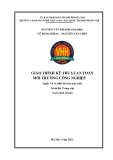

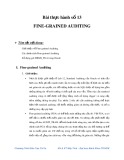
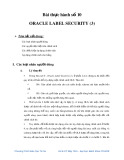
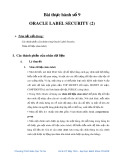
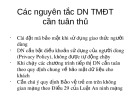
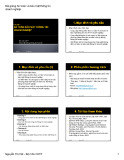







![Sổ tay Kỹ năng nhận diện & phòng chống lừa đảo trực tuyến [Mới nhất]](https://cdn.tailieu.vn/images/document/thumbnail/2025/20251017/kimphuong1001/135x160/8271760665726.jpg)
![Cẩm nang An toàn trực tuyến [Mới nhất]](https://cdn.tailieu.vn/images/document/thumbnail/2025/20251017/kimphuong1001/135x160/8031760666413.jpg)







